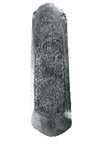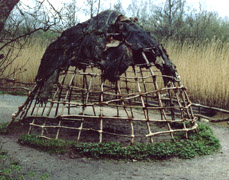


From Lake Boora,
Co.Offaly
National Museum of Ireland
National Museum of Ireland
Courtesy Irish National Heritage Park, Ferrycarrig, Wexford
Mesolithic settlers in Ireland have been described by some archaeologists as leading 'an easy life' and being 'an affluent society' because there must have been food in abundance in the country at the time.
Ireland was densely wooded and most of the Mesolithic settlements that have been found were near the sea, rivers and lakes. Those early settlers could find food with little effort, gathering shellfish such as oysters, mussels, limpets and periwinkles on the shore. Excavations have shown that they also ate salmon, trout, other fish and eels. Of plant foods, they ate large quantities of hazelnuts which can be stored for winter. They ate seeds, especially water-lily seeds and they may have eaten birds' eggs as well as leaves, roots and small creatures we no longer eat today.
They hunted, especially in winter, for wild pig, hare, pigeon, duck and grouse and they probably moved around to some extent according to the season.
But the stereotype of 'man-the-hunter' on whom society was totally dependant, seems unfounded as it is now believed that most food was gained by gathering, an activity in which women, men and even children could co-operate.
| Indeed, because of the generally better preservation of bone on archaeological sites, compared to that of plant foods, it may well be that the importance of hunting in temperate Europe has been overestimated. Gabriel Cooney and Eoin Grogan, Irish prehistory: a social perspective, Dublin, 1994, p. 7. |
Archaeologists have found post holes of their huts set at an angle, showing that they lived in dome-shaped huts most likely covered with sods or animal skins. Their clothes were probably made from skins also; neither flax nor sheep's wool were available in Ireland as yet, but they may have used other natural fibres and materials.
With tools made from flint, chert, wood and bone, they cleaned and peeled vegetables and fruit, shelled nuts and ground seeds. They hunted and fished, lit fires and cooked and they may have known how to preserve food by salting, drying or smoking. They drew water and scraped, cured and sewed skins for clothes and shelter and built and repaired their huts. No evidence of their burial customs has yet been found in Ireland.
 |
 |
 |
|
Early Mesolithic axehead
From Lake Boora, Co.Offaly National Museum of Ireland |
Simple knife made from Bann flake, moss and string
National Museum of Ireland |
Mesolithic house being built - modern reconstruction
Courtesy Irish National Heritage Park, Ferrycarrig, Wexford |
Archaeology provides limited information about the social life and culture of prehistoric peoples but anthropologists have studied groups leading similar lifestyles in modern times.
| Anthropologists have found that the status of women is regularly higher in forager groups than in any other type … Their organisation is based on equality between individuals and between sexes … One key to this equality is the lack of private property or possessions within the society, and the impossibility for the nomadic forager band of storing food. One person cannot therefore own more than another, nor can dependence or debt to another build up in a way which makes oppression and submission a likely outcome. Margaret Ehrenberg, Women in Prehistory, London, 1989, p. 65. |
We can only speculate and never really be sure about the kind of society that obtained in Ireland during the Mesolithic era.